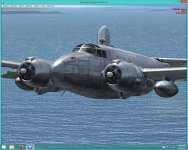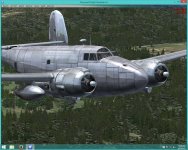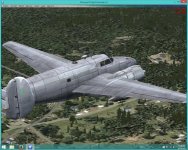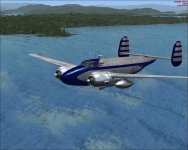Can anyone advise on the differences between the members of this Lockheed family?
Lodestar, Harpoon, Ventura, Hudson? Have I missed any? Howard as well? Or is the Howard a civvie conversion?
Many thanks,
Robin
I found this:
http://www.uswarplanes.net/lockheedtwin.html
&
http://www.burbanksbest.com/
that explains all.
Here is a different view:
In 1939, the company Lockheed Aircraft Corporation has decided to expand their family fast twin-engined airliners new aircraft with a larger capacity. This was because of the competitive struggle with the company Douglas , who successfully sold and the United States and abroad their planes Douglas DC-3 (DST) . The new plane, named the Lockheed L-18 "Lodestar" , applied a lot of design elements from the previous construction of the Lockheed L-14 "Super Electra" , including almost completely wing. In contrast, the hull was new, longer and higher, fit 15-18 passengers in further versions of their number increased to 26 Wishing to meet the requirements of potential customers, has developed a number of different engine version Pratt & Whitney ( L-18-07 , L-18-08 , L-18-10 , L-18-14 ) and Wright ( L-18-40 , L-18-50 , L-18-56 ) with a power of 490 HP to 650 HP. Three prototypes "Lodestar" arose as a result of the reconstruction serial aircraft Lockheed L-14H . The first of these was flown on 09/21/1939, the first production aircraft took to the air on 02/02/1940
Operation of the L-18 was launched in March 1940, however, the U.S. aircraft has not won widespread popularity, most of the lines operated slower but more capacious aircraft DC-3 . Only 43 aircraft (including improved versions of the L-118 and L-218 ) was able to sell different airlines, most acquired the Pan Am-12 exam further 96 aircraft were sold abroad, including 38 in the UK and 29 for South Africa. Were also used in Brazil, Canada, France, the Dutch East Indies (now Indonesia), Norway and Venezuela.
In May 1941, the USAAF purchased one plane L-18-20 (under the designation C-56 ), and three L-18-14 (as a C-57 ), followed by a further 10 copies of the C-57 . They were ordinary passenger aircraft that served to transport staff officers. When the U.S. joined World War II, was purchased for the purpose of military aviation aviation certain number of aircraft L-18 "Lodestar" different versions. In the years 1941-1943 developed into large-lot production aircraft to transport aviation. Versions built for the USAAC:
- C-56 - driven motors Wright R-1820 with a capacity of 760 hp, built 1 copy,
- C-56A , C-56B , C-56C , C-56D , C-56E - powered versions Pratt & Whitney R-1690. Built 25 copies,
- C-57A - driven engines Pratt & Whitney R-1830. Built 1 copy,
- C-57B - driven engines Pratt & Whitney R-1830. Built seven copies,
- C-57C - a variant of the C-60A powered by Pratt & Whitney R-1830-51. Built 3 copies,
- C-57D - a variant of the C-57A powered by Pratt & Whitney R-1830-92. Built 1 copy,
- C-59 ( "Lodestar" Mk ) - version powered by Pratt & Whitney R-1690 "Hornet". Built 10 copies,
- C-60 ( "Lodestar" Mk.II ) - powered motors Wright R-1820-87. 36 impressed L-18-56 aircraft,
- C-60A - driven engines Wright R-1820-87 (not Pratt & Whitney R-1830 "Twin Wasp"). Built 324 (not 125) copies
- XC-60B - a variant of the C-60A with an experimental system przeciwoblodzeniowym. Built 1 copy,
- C-60C - design of transport aircraft designed to transport 21 soldiers, was not realized,
- C-66 - driven motors Wright R-1820-87. 1 aircraft were built for the Air Force handed over Brazil.
Versions built for the U.S. Navy:
- XR5O-1 - fueled engines Wright R-1820-40 895 kW. Built 1 copy,
- R5O-1 - fueled engines Wright R -1820-97 895 kW. Built 3 copies, one was transferred to the United States Coast Guard
- R5O-2 - driven engines Pratt & Whitney R-1690-25 Power 634 kW. Built 1 copy,
- R5O-3 - driven engines Pratt & Whitney R-1830-34A 895 kW. Initially, it was a VIP transport aircraft for 4 passengers. Built 4 copies,
- R5O-4 - driven motors Wright R-1820-40 895 kW. He is a staff transport aircraft for 7 passengers. Built 12 copies,
- R5O-5 - driven motors Wright R-1820-40 895 kW. Similar to R5O-4 but with seating for 14 passengers. Built 14 copies,
- R5O-6 - marking 35 aircraft C-60A-5-LO have been provided by the USAAC to the U.S. Navy (U.S. Marine Corps), to carry an 18 soldiers.
In the years 1941-1943 developed into large-lot production aircraft to transport aviation. For the USAAF built 10 copies of the C-59 , 30 copies of the C-60 (of which 15 passed the UK) and 325 copies of the C-60A . They croaked simplified equipment cabin and reinforced floor. Aircraft were unarmed versions of the C-60 and C-60A cabin windows were holes to keep the fire from small arms landing. Approx 100 copies delivered to the U.S. Navy aviation. A total of 625 aircraft were built from the family of the Lockheed L-18 "Lodestar" .Transport aircraft family Lockheed L-18 "Lodestar" were used in military aviation: Australia, Brazil, the Dutch East Indies, Canada, New Zealand, Norway, South Africa, USA, UK.
Based on the Lockheed L-18 "Lodestar" was built maritime patrol aircraft Lockheed "Ventura" .
After World War II transport aircraft were withdrawn from military aviation and sold to civilian customers. They were used by airlines in Canada, New Zealand, South Africa, Portugal and the UK.
In Poland during World War II, the Polish pilots ferry from N ° 1 ADU/ME- English Detachment Takoradi way back (Cairo-Takoradi) when the aircraft is done in groups, among others, on board civil aircraft L-18-07/08 Lockheed "Lodestar" British overseas line BOAC (British Overseas Airways Corporation). Polish airmen often led these machines, flying in the composition of the crews of BOAC.
.









